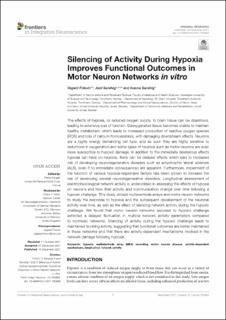| dc.contributor.author | Fiskum, Vegard | |
| dc.contributor.author | Sandvig, Axel | |
| dc.contributor.author | Sandvig, Ioanna | |
| dc.date.accessioned | 2022-03-02T08:55:14Z | |
| dc.date.available | 2022-03-02T08:55:14Z | |
| dc.date.created | 2021-12-02T21:24:51Z | |
| dc.date.issued | 2021 | |
| dc.identifier.citation | Frontiers in Integrative Neuroscience. 2021, 15 1-12. | en_US |
| dc.identifier.issn | 1662-5145 | |
| dc.identifier.uri | https://hdl.handle.net/11250/2982319 | |
| dc.description.abstract | The effects of hypoxia, or reduced oxygen supply, to brain tissue can be disastrous, leading to extensive loss of function. Deoxygenated tissue becomes unable to maintain healthy metabolism, which leads to increased production of reactive oxygen species (ROS) and loss of calcium homoeostasis, with damaging downstream effects. Neurons are a highly energy demanding cell type, and as such they are highly sensitive to reductions in oxygenation and some types of neurons such as motor neurons are even more susceptible to hypoxic damage. In addition to the immediate deleterious effects hypoxia can have on neurons, there can be delayed effects which lead to increased risk of developing neurodegenerative diseases such as amyotrophic lateral sclerosis (ALS), even if no immediate consequences are apparent. Furthermore, impairment of the function of various hypoxia-responsive factors has been shown to increase the risk of developing several neurodegenerative disorders. Longitudinal assessment of electrophysiological network activity is underutilised in assessing the effects of hypoxia on neurons and how their activity and communication change over time following a hypoxic challenge. This study utilised multielectrode arrays and motor neuron networks to study the response to hypoxia and the subsequent development of the neuronal activity over time, as well as the effect of silencing network activity during the hypoxic challenge. We found that motor neuron networks exposed to hypoxic challenge exhibited a delayed fluctuation in multiple network activity parameters compared to normoxic networks. Silencing of activity during the hypoxic challenge leads to maintained bursting activity, suggesting that functional outcomes are better maintained in these networks and that there are activity-dependent mechanisms involved in the network damage following hypoxia. | en_US |
| dc.language.iso | eng | en_US |
| dc.publisher | Frontiers | en_US |
| dc.relation.uri | https://www.frontiersin.org/articles/10.3389/fnint.2021.792863/full?&utm_source=Email_to_authors_&utm_medium=Email&utm_content=T1_11.5e1_author&utm_campaign=Email_publication&field=&journalName=Fronti | |
| dc.rights | Navngivelse 4.0 Internasjonal | * |
| dc.rights.uri | http://creativecommons.org/licenses/by/4.0/deed.no | * |
| dc.title | Silencing of activity during hypoxia improves functional outcomes in motor neuron networks in vitro | en_US |
| dc.type | Peer reviewed | en_US |
| dc.type | Journal article | en_US |
| dc.description.version | publishedVersion | en_US |
| dc.source.pagenumber | 1-12 | en_US |
| dc.source.volume | 15 | en_US |
| dc.source.journal | Frontiers in Integrative Neuroscience | en_US |
| dc.identifier.doi | 10.3389/fnint.2021.792863 | |
| dc.identifier.cristin | 1963857 | |
| dc.relation.project | ALS Norge: x | en_US |
| dc.relation.project | Samarbeidsorganet mellom Helse Midt-Norge og NTNU: 2018/42521 | en_US |
| cristin.ispublished | true | |
| cristin.fulltext | original | |
| cristin.qualitycode | 1 | |

